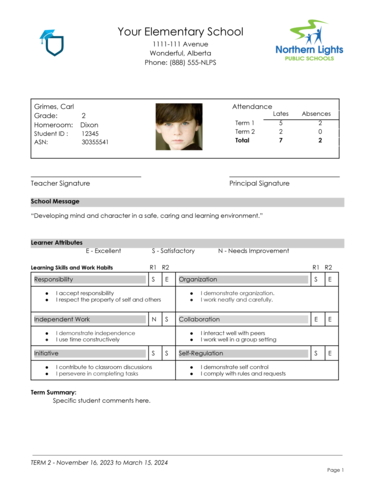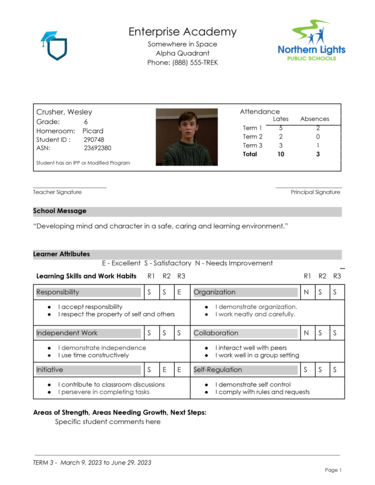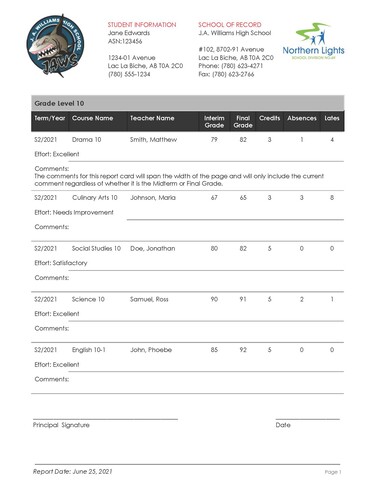Parents and guardians are provided with information about student learning and progress in a variety of ways throughout the school year. This may include:
- PowerSchool Parent Portal
- Phone calls or notes from teachers
- Student portfolios
- Parent-teacher interviews/conferences
- Student-led conferences
- Student self-assessments
- Parent feedback forms
- Progress reports
- Report cards
Parents and guardians of Kindergarten students are provided with opportunities in November and March to meet with teachers and discuss students' strengths and areas for growth.
Formal report cards are provided to parents and guardians at the end of the school year. This report focuses on student achievement in the seven learning areas identified for Kindergarten students.
Outcomes-Based Report Cards
For students in Kindergarten to Grade 4, Northern Lights Public Schools primarily uses Outcomes-Based report cards. These look a little different than what some parents may remember from their own report cards, as it does not include traditional letter grades (A, B, C, D, F) or percentages.
In Alberta, curriculum is based on outcomes. An outcome clearly describes what a student is expected to know, understand and be able to do in each subject area. An Outcomes-Based report card focuses on descriptions of how well a student has acquired the key learning outcomes in each subject. It identifies a student's strengths, areas requiring growth, and the next steps for continued learning and success.
The goals of an Outcomes-Based report card are to:
- provide parents and guardians with a realistic description of their child's learning;
- confirm the student's achievement relative to provincial expectations, without comparison to others;
- provide parents with a summary of their child's behaviour and attitude at school and how much effort their child has invested in learning; and,
- suggest strategies for parents/guardians and students with respect to the next steps in the learning process.
Achievement Descriptors
Student learning is reported using Achievement Descriptors. These describe how well the student has met the key learning outcomes. For students in Kindergarten, four Achievement Descriptors are used:
- Proficient (P)
The skill or learning outcome is demonstrated consistently by the student and evidence of learning indicates a solid level of understanding. - Approaching (A)
The skill or learning outcome is developing and evidence of learning indicates a basic level of understanding. - Not Yet (NY)
The skill or learning outcomes has not yet been demonstrated, the student requires direct support, or evidence of learning is minimal. - Not Applicable (NA)
No instruction for subject/strand for reporting period.

Parents and guardians of students in Grades 1-4 receive three summative report cards each year. Report cards are distributed at most schools in November, March and June. The fall and spring report cards are followed by opportunities for parents and guardians to meet with teachers to discuss student progress.
Outcomes Based Report Cards
For students in Kindergarten to Grade 4, Northern Lights Public Schools primarily uses Outcomes-Based report cards. These look a little different than what some parents may remember from their own report cards, as it does not include traditional letter grades (A, B, C, D, F) or percentages.
In Alberta, curriculum is based on outcomes. An outcome clearly describes what a student is expected to know, understand and be able to do in each subject area. An Outcomes-Based report card focuses on descriptions of how well a student has acquired the key learning outcomes in each subject. It identifies a student's strengths, areas requiring growth, and the next steps for continued learning and success.
The goals of an Outcomes-Based report card are to:
- provide parents and guardians with a realistic description of their child's learning;
- confirm the student's achievement relative to provincial expectations, without comparison to others;
- provide parents with a summary of their child's behaviour and attitude at school and how much effort their child has invested in learning; and,
- suggest strategies for parents/guardians and students with respect to the next steps in the learning process.
Achievement Descriptors
Four achievement descriptors are used for students in grades 1 to 4:
- Exemplary (E)
The student has an in-depth understanding of the outcomes and produces excellent quality work. This student is capable of working independently in order to understand the outcomes, skills and strategies. - Proficient (P)
The student has a consistent understanding of the outcomes and produces high quality work. The student requires minimal assistance or support in order to understand the outcomes, skills and strategies - Approaching (A)
The student has a basic understanding of the outcomes and produces work of a satisfactory quality. The student requires some assistance in order to understand the outcomes, skills and strategies. - Not Yet (NY)
The student is not meeting grade level expectations, and requires significant assistance to understand the outcomes, skills and strategies.
Learner Attributes
Report cards also include information on Learner Attributes. Learner Attributes are learning skills and work habits that are important factors in a student‘s success. These include responsibility, independent work, initiative, organization, collaboration, and self-regulation. These are reported separately from student achievement.
The following indicators are used when reporting on Learner Attributes:
- Excellent
- Satisfactory
- Needs Improvement

Parents and guardians of students in Grades 5-8 receive three summative report cards each year. Report cards are distributed at most schools in November, March and June. The fall and spring report cards are followed by opportunities for parents and guardians to meet with teachers to discuss student progress.
For students in grades 5 to 8, progress reports and report cards are primarily Outcomes-Based, but also include percentages for assessments related to the four core subjects of Language Arts, Mathematics, Science, and Social Studies. This is determined using a variety of student assessments and teachers’ professional judgment.
Outcomes-Based Report Cards
In Alberta, curriculum is based on outcomes. An outcome clearly describes what a student is expected to know, understand and be able to do in each subject area. An Outcomes-Based report card focuses on descriptions of how well a student has acquired the key learning outcomes in each subject. It identifies a student's strengths, areas requiring growth, and the next steps for continued learning and success.
The goals of an Outcomes-Based report card are to:
- provide parents and guardians with a realistic description of their child's learning;
- confirm the student's achievement relative to provincial expectations, without comparison to others;
- provide parents with a summary of their child's behaviour and attitude at school and how much effort their child has invested in learning; and,
- suggest strategies for parents/guardians and students with respect to the next steps in the learning process.
Achievement Descriptors
Four achievement descriptors are used for students in grades 5 to 8:
- Exemplary (E)
The student has an in-depth understanding of the outcomes and produces excellent quality work. This student is capable of working independently in order to understand the outcomes, skills and strategies. - Proficient (P)
The student has a consistent understanding of the outcomes and produces high quality work. The student requires minimal assistance or support in order to understand the outcomes, skills and strategies - Approaching (A)
The student has a basic understanding of the outcomes and produces work of a satisfactory quality. The student requires some assistance in order to understand the outcomes, skills and strategies. - Not Yet (NY)
The student is not meeting grade level expectations, and requires significant assistance to understand the outcomes, skills and strategies.
Learner Attributes
Report cards also include information on Learner Attributes. Learner Attributes are learning skills and work habits that are important factors in a student‘s success. These include responsibility, independent work, initiative, organization, collaboration, and self-regulation. These are reported separately from student achievement.
The following indicators are used when reporting on Learner Attributes:
- Excellent
- Satisfactory
- Needs Improvement

In high school (grades 9 to 12), students receive a percentage grade in all subjects. This is determined using a variety of student assessments and teachers’ professional judgment.
At our high schools that have two semesters, parents and guardians receive a mid-semester progress report (November and March) and an end of semester report card (end of January and end of June).
At our high schools that follow the quarterly system, parents and guardians receive report cards at the end of each quarter.
Assessment Glossary
| Term Used | Description |
| Assessment | Process of collecting information on student achievement and performance that includes a variety of assessment tasks designed to monitor and improve student learning. |
| Assessment for Learning | Assessment experiences that result in an ongoing exchange of information between students and teachers about student progress toward clearly specified learner outcomes (also called diagnostic and formative assessment; refers to information not used for grading purposes) |
Assessment of Learning |
Assessment experiences designed to collect information about learning to make judgments about student performance and achievement at the end of a period of instruction to be shared with those outside classrooms (also called summative assessment; refers to performance data compiled as a grade) |
| Checklist | A two-point evaluation tool that indicates if a student has achieved a learner outcome [yes or not yet] |
| Criteria | What students need to do to show they have achieved the learner outcomes (e.g. compare and contrast, explain, analyze) |
| Descriptive Feedback | Part of an ongoing, specific and constructive conversation about learning that relates directly to the learner outcomes |
| Evaluation | Making decisions about the quality, value or worth of a response for the purpose of providing descriptive feedback (formative) and marks (summative) |
| Grade (mark) | A letter, number or comment reported at the end of a period of time as a summary statement of student performance based on a variety of summative assessments |
| Grading | A process to determine a student’s performance level Learner Outcomes What we expect students to learn; the provincially mandated knowledge, skills and attitudes we expect students to demonstrate |
| Peer-Coaching |
One student considering the quality of another’s work and providing feedback by applying criteria to help improve performance; requires a non-threatening and supportive relationship between the peers (also referred to in the literature as peer-assessment, peer-evaluation, peer- tutoring, or peer-editing) |
| Performance Level |
How well a student demonstrates grade level learner outcomes represented by a grade (mark) |
| Performance Assessment |
A meaningful, real-life task that enables students to demonstrate what they know and can do in situations like those they will encounter outside the classroom as well as in situations that simulate how people do their work |
| Rating Scale |
An evaluation tool of three or more points that illustrates how frequently, consistently or independently a student demonstrates a learner outcome |
| Rubric |
A fixed measurement scale and list of criteria that describe the quality of products or performances used to evaluate a student’s performance |
| Self-Reflection |
Considering the quality of one’s own work by applying criteria; requires that a student feels safe enough to be honest in making objective observations about the work (also referred to in the literature as self-assessment or self-evaluation) |
| Triangulation of Evidence |
Describes how evidence accumulated from three main sources, over a period of time is considered collectively to ensure validity and reliability of assessment. (For example: observations from anecdotal records and checklists, reports from self-assessments and conferences, and evidence from the products of students’ work are combined to inform judgments about students’ achievement of learning outcomes). |
| Triangulate |
To consider assessment information from observations, products and conversations to determine how well students learned what they need to know and be able to do for a grade level or course. |
| Validity |
An assessment method is valid if it measures student achievement of the learning outcomes that the assessment was intended to measure. It also means that an overall judgment of student achievement is based on a representative and varied body of assessment information. |
Academic Integrity
For assessment to be meaningful for both the student and teacher, students are expected to engage in the highest level of honesty in their work and submit work that accurately reflects their knowledge and understanding of the curriculum. There will be non-academic consequences for work that lacks academic integrity. This includes plagiarism, fabrication, cheating, sabotage, and impersonation.
Related Links
Assessment
Curriculum
NLPS Policies and Procedures
Administrative Procedure 240 - Student Assessment and Reporting
